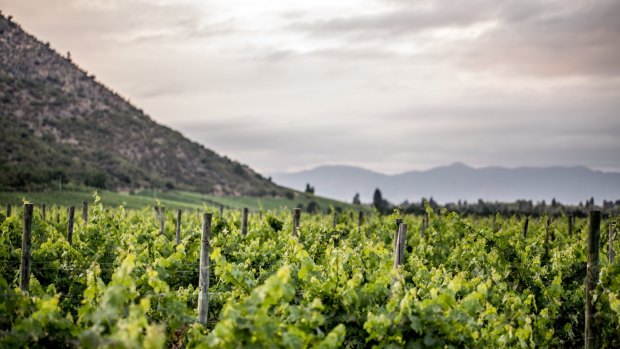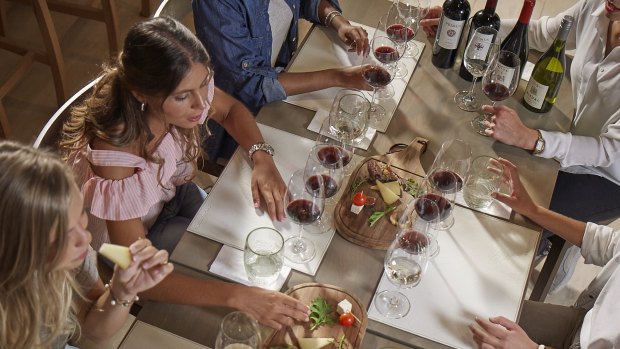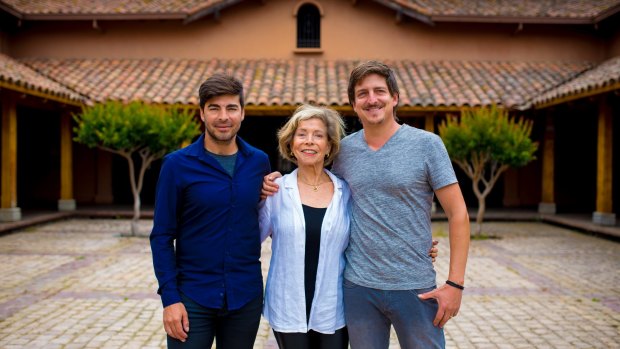This was published 4 years ago
Tour vineyards and meet winemakers in Chile's Casablanca Valley
By Elspeth Callender

Veramonte Winery in the Casablanca Valley, which produces more than 2.1 million bottles of wine a year.Credit: Bennett Sell-Kline
"Numbers are soulless," says Sofia Araya, so she tastes the grapes all the way up to harvest. "Stainless steel is dead," so she favours storing the wine in concrete eggs and oak barrels before bottling. Araya recently oversaw the production of Veramonte's first organic wines. Now this thirty-something, Chilean-born winemaker is letting her gut instinct lead her down the biodynamic path.
It's March, the first month of grape harvest in Chile, and Araya is showing us around Veramonte Winery in the Casablanca Valley. I'm on a week-long &Beyond tour travelling with a small group of Europeans spread across two four-wheel drive vehicles.
With the buzz and barrios of Santiago behind us, we have a couple of days to explore some of the wine regions of this trickle-thin South American country. I don't realise it at the time but my long-held, and not uncommon, belief that Chile only produces average wine is about to be stomped all over like grapes in a barrel.

A wine tasting at Veramonte Winery.
Sofia Araya is part of a new wave of individuals who don't fit Chile's traditional image of a winemaker but, over the past two decades, have infiltrated the industry. With their fresh eyes, innovative techniques and propensity for risk-taking, they've significantly raised the quality and increased the diversity of Chilean wine.
"Harvest is a very fun time of year. Very intense in every way but also very fun," says Araya as she walks us from the yeast-scented barrel room out into the sun. People are hand-sorting grapes alongside trailers of fruit softening in dry ice. Vines are stripes of green, yellow, orange and red against the desert-grey earth.
Araya started at Veramonte as an assistant winemaker in 2010 and is now head winemaker at four different wineries. Veramonte alone produces more than 2.1 million bottles each year. The estate's organic vineyard lies further south in Chile's Colchagua Valley. Though, as Araya explains, "we're not selling organic wine – we're selling good wine that happens to be organic". The removal of ammonia from the production process was primarily to improve wine quality.

Winemaker Maria Luz Marin, of Casa Marin, with her sons.
Wine has been produced in Chile since Spanish colonisers first planted grapes here in the 16th century. Yet Chilean winemaking has been far more influenced by the French – predominantly the Bordeaux region – due to a fashion in which wealthy landowners would visit France and then import their grapes. After the dreaded phylloxera epidemic in Europe in the mid-1800s many ruined French winemakers relocated their knowledge and expertise to South America.
Now about 200,000 hectares of vineyards patchwork Chile's valleys and foothills. (By comparison, Australia has approximately 160,000 hectares, Argentina 225,000 and France more than 800,000.) Chile's wine regions extend from the Elqui Valley, up near the Atacama Desert, at a latitude of 29 degrees south – where some vineyards sit at an elevation of 2000 metres – down to the Malleco Valley at a latitude of about 46 degrees south. If Chile was divided, horizontally, into four even pieces then its wine producing section would be the second chunk down.
Such a difference in latitude supports a wide range of grapes but winemakers predominantly grow cabernet sauvignon, mendoza, merlot, pinot noir, syrah, chardonnay and sauvignon blanc. And, in the coolest areas, gewurztraminer, riesling and viognier. There's also this other one I keep hearing about that sounds far more like an opera than a grape. Carmenere is an original Bordeaux grape named for its deep crimson colour. Its extinction was mourned until the mid-1990s when it was found alive and well in Chile where everyone had been calling it late-harvest merlot.
I taste my first carmenere in a humble shed at boutique vineyard La Recova, also in the Casablanca Valley, and love its peppery earthiness. Owner, Brazilian-born David Giacomini, moved to Chile with his family at 13 and, as an adult, bought this steep, sunny, east-west canyon that has its own micro-climate. When vegetable growing didn't work out Giacomini planted sauvignon blanc.
Some of his rows are so close to each other they can only be accessed, tended to and harvested by a person on foot. Pruned branches lie piled at the end of each row ready to be burnt if there's any threat of frost. La Recova produces about 40,000 nitrate-free bottles a year. After a wander and a tasting we have a long boozy lunch of mainly steak and avocado, mid-vineyard, at tables set up under a shade cloth.
In Chile today, you can still find traditional vineyards making reasonable wine. Such as 170-year-old Bodegas RE, which has been passed down through many generations of the same winemaking family, all of whom seem to be called Pablo – even the newest baby boy. And Bouchon Family Wines, in the Maule Valley, set on a horse ranch with an adobe colonial homestead. We stop in there for a lunch of blood pudding empanadas and steaks cooked over coals.
Then there's Casa Marin, in the San Antonio Valley, established as recently as 2000. When Maria Luz Marin decided on the granite and limestone soil slopes above the village of Lo Abarca to establish her winery, just about everyone believed her vineyard would fail. It was too close to the sea, too cold, too windy, too foggy, too radical to be viable. But Luz Marin had self-belief. The severe weather conditions have borne strong resilient plants yielding superior quality fruit and Casa Marin has, for many years, produced some of Chile's best and most internationally-awarded premium wines.
Luz Marin tells me she's proud of everything she's created on her 46-hectare vineyard. "But the one that has given us the most recognition is our sauvignon blanc cipreses," she says of a vibrant, pungent biodynamic white. One of her sons, Felipe, is now Casa Marin's winemaker and together they've plotted to add another four hectares and plant chardonnay for the first time.
We drive to the highest point of Casa Marin – the only vineyard in the country with sea views – where the agriculture almost defies gravity. Up there I'm reminded how much every winemaker, no matter how passionate and hardworking, is constrained by terroir, especially here in a country of extreme climate and landscape bordered by the Pacific Ocean and the Andes Mountains.
Terroir, if you don't know (I didn't), is a wine-world word encompassing all the elements of the natural environmental where grapes are grown including climate, soil composition, position on a slope, steepness of the slope, altitude, presence of water and drainage. Marin's personal definition is the combination of soil, climate and human intervention. Her approach, she says, has always been to "understand and accept what nature gives you without changing its essence but showing exactly the sense of place".
At Vina Vik in Millahue, much further south, no expense has been spared on the design and architecture of a cutting-edge winery and luxury retreat on a 4325-hectare vineyard. There, over an evening of premium red blends that cost well over $100 a bottle, any residual attitudes I might have held about Chilean wine get well and truly smashed.
FIVE MORE THINGS TO DO IN CHILE
MEET THE PEOPLE
The Mapuche, a name meaning "people of the land", are the largest indigenous group of Chile. Experience their culture within the Araucania region. See chile.travel
SOAK IT UP
In a misty gorge of the Araucania region hot spring waters are captured and contained at Termas Geometricas. Red wooden walkways connect many slate-lined pools. See termasgeometricas.cl
RIDE THAT HORSE
From galloping across the Atacama Desert to trotting through a Central Valley vineyard led by a huasa or huaso, travelling on horseback is a classic way to experience Chile.
EXPLORE SANTIAGO
The districts of Chile's capital city are made up of barrios each with their own personality and aesthetic. Visit Bellavista for street art and bars and restaurants, or Lastarria for European architecture and cobbled streets. See chile.travel
BECOME AN AFICIONADO
Between wine tastings get acquainted with the country's national drink: pisco sour. This alcoholic cocktail originated in Peru and my favourites were at Santiago's tiniest backstreet bars.
TRIP NOTES
MORE
FLY
LATAM flies to Santiago five times a week direct from Melbourne and daily from Sydney via Auckland. See latam.com
STAY
Boutique hotel Cumbres Lastarria is located in Santiago's vibrant Lastarria Quarter. Double rooms from $US89. See cumbreslastarria.com
TOUR
Visit some of Chile's key wine regions as part of an eight-day Fine wines and Great Cities of Chile and Argentina trip with &Beyond, from $US10,450 a person. See andbeyond.com
Elspeth Callender travelled as a guest of &Beyond.
Sign up for the Traveller Deals newsletter
Get exclusive travel deals delivered straight to your inbox. Sign up now.